The Rice Water Skincare Market is estimated to be valued at USD 7.2 billion in 2025 and is projected to reach USD 13.2 billion by 2035, registering a compound annual growth rate (CAGR) of 6.2% over the forecast period.
The Rice Water Skincare market is experiencing steady growth, driven by increasing consumer preference for natural and plant-based cosmetic ingredients and rising awareness of skin health and hydration. Rice water, known for its high concentration of vitamins, minerals, and antioxidants, is being increasingly incorporated into skincare formulations to improve skin texture, reduce dryness, and enhance radiance. Rising demand for moisturizers and hydrating products is being supported by the growing focus on preventive skincare routines and self-care trends across global markets.
Market adoption is further fueled by social media influence, digital marketing campaigns, and endorsements by skincare professionals and beauty influencers, which are shaping consumer choices. Manufacturers are increasingly investing in research and development to enhance product efficacy and address specific skin concerns, while also offering sustainable and ethically sourced formulations.
With growing emphasis on personalized skincare, natural ingredients, and cruelty-free products, the Rice Water Skincare market is expected to witness sustained growth Increasing urbanization, rising disposable incomes, and heightened awareness of skin protection measures are creating long-term opportunities for market expansion.
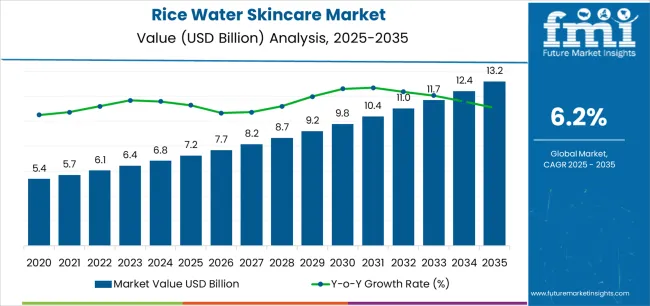
| Metric | Value |
|---|---|
| Rice Water Skincare Market Estimated Value in (2025 E) | USD 7.2 billion |
| Rice Water Skincare Market Forecast Value in (2035 F) | USD 13.2 billion |
| Forecast CAGR (2025 to 2035) | 6.2% |
The market is segmented by Product Type, Skin Type, Consumer Orientation, and Sales Channel and region. By Product Type, the market is divided into Moisturizers, Face Packs/Masks, Cleansers, Toners, Serums, and Other Skin Care Products. In terms of Skin Type, the market is classified into Dry Skin, Normal Skin, Oily Skin, Sensitive Skin, Combination Skin, and Acne Prone Skin. Based on Consumer Orientation, the market is segmented into Women, Men, and Unisex. By Sales Channel, the market is divided into Online Retailers, Hypermarkets/Supermarkets, Specialty Stores, Drug Stores & Pharmacies, Convenience Stores, and Other Sales Channel. Regionally, the market is classified into North America, Latin America, Western Europe, Eastern Europe, Balkan & Baltic Countries, Russia & Belarus, Central Asia, East Asia, South Asia & Pacific, and the Middle East & Africa.
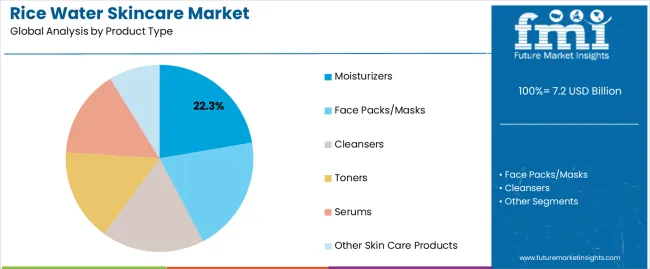
The moisturizers product type segment is projected to hold 22.3% of the market revenue in 2025, establishing it as the leading product type. Growth in this segment is being driven by the rising need for hydrating solutions suitable for daily skincare routines across different skin types. Moisturizers formulated with rice water are particularly valued for their ability to retain skin moisture, enhance elasticity, and reduce dryness without causing irritation.
Their adoption is being reinforced by increasing consumer awareness of preventive skincare and the desire to maintain a healthy complexion. Manufacturers are focusing on enhancing product formulations through the incorporation of additional natural extracts, vitamins, and botanical ingredients, which improve efficacy and appeal.
The convenience, ease of application, and visible results associated with moisturizers are further driving consumer preference With the growing trend of combining natural ingredients with scientifically backed skincare benefits, moisturizers are expected to remain the dominant product type, supported by continued innovation, marketing initiatives, and increasing consumer trust in plant-based skincare solutions.
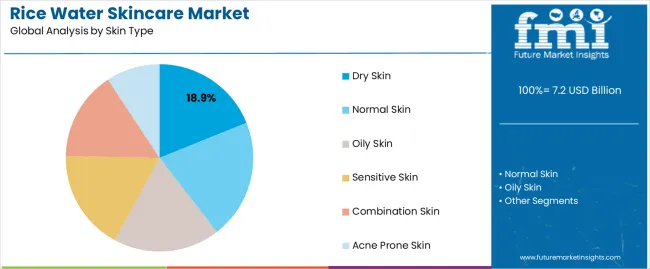
The dry skin segment is anticipated to account for 18.9% of the market revenue in 2025, making it the leading skin type category. Growth in this segment is driven by the high prevalence of dryness-related skin concerns, which include flakiness, rough texture, and reduced elasticity. Rice water-based skincare products are particularly effective for dry skin due to their hydrating, soothing, and nourishing properties.
These products help restore skin barrier function and improve overall moisture retention, enhancing comfort and appearance. The adoption of targeted formulations for dry skin is being reinforced by rising consumer awareness regarding personalized skincare routines and the need for solutions addressing specific skin conditions.
Continuous research into optimizing rice water extraction, formulation stability, and ingredient synergy has strengthened product performance, increasing consumer confidence As the demand for natural and effective hydration solutions grows globally, products catering to dry skin are expected to maintain their leading position in the Rice Water Skincare market, driven by efficacy, consumer education, and targeted marketing strategies.
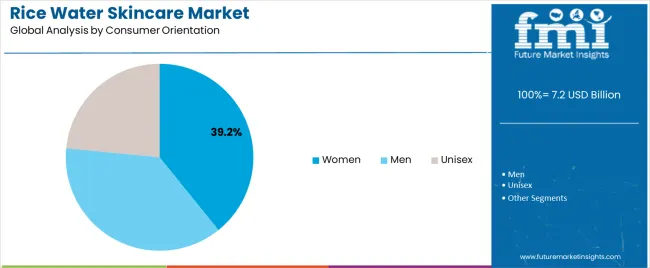
The women consumer orientation segment is expected to hold 39.2% of the market revenue in 2025, establishing it as the largest consumer group. Growth is being driven by the increasing interest among women in skincare routines that incorporate natural, plant-based ingredients with visible benefits. Women are increasingly seeking products that address hydration, skin brightness, and anti-aging, with rice water formulations offering multifunctional benefits.
Social media campaigns, influencer endorsements, and digital marketing have significantly increased product awareness and trial among female consumers. Brands are tailoring packaging, formulations, and product messaging specifically to meet the preferences and needs of women, further reinforcing adoption.
The segment is also benefiting from higher purchasing power, rising disposable income, and a growing focus on self-care and wellness As awareness of preventive and natural skincare solutions increases, women are expected to remain the dominant consumer orientation segment in the Rice Water Skincare market, driving product innovation, marketing strategies, and revenue growth.
In 2020, the global rice water skincare market was predicted to reach a valuation of USD 5.4 billion, according to Future Market Insights. The rice water skincare market witnessed significant growth, registering a CAGR of 4.6% from 2020 to 2025.
| Historical CAGR | 4.6% |
|---|---|
| Forecast CAGR | 6.5% |
The global rice water skincare market has shown economic growth in recent years, upgraded by factors such as a boom in consumer preference for natural and organic skincare products, a boost in awareness about the benefits of rice water in skincare, and ongoing demand for products with anti-aging and skin brightening properties.
From 2020 and 2025, the market demonstrated a CAGR of 4.6%, reflecting sustained demand and adoption of rice water-based skincare products across various regions. The accelerated push underscored the resilience and attractiveness of the market amidst the evolvement of consumer preferences and industry dynamics.
Rice water is rich in vitamins, minerals, and amino acids and is believed to nourish and rejuvenate the skin. Consumers preferably prioritize clean and natural ingredients for their skincare routines, and products featuring rice water as their key component.
The below section shows the leading segment. Based on the product type, the moisturizers segment is accounted to hold a market share of 22.3% in 2025. Based on skin type, the dry skin segment is accounted to hold a market share of 18.9% in 2025.
The demand for moisturizers continues to upgrade as people become more aware of the importance of maintaining well-hydrated skin in preventing dryness, premature aging, and other skin concerns.
Rice water-based skincare products are known for their hydrating and soothing properties that offer a gentle and natural solution for addressing dry skin concerns.
| Category | Market Share in 2025 |
|---|---|
| Moisturizers | 22.3% |
| Dry Skin | 18.9% |
Based on product type, the moisturizer segment is accounted to hold a market share of 22.3% in 2025. Moisturizers are essential skincare products as they are designed for their hydration and nourishment of the skin, which is needed in daily skincare routines for consumers worldwide.
The popularity of moisturizers is attributed to their ability to address various skin concerns, including dryness, dullness, and premature aging.
Unique benefits like hydration, brightening, and soothing effects are offered by rice water-based moisturizers that are derived from the natural properties of rice water.
Products like these are particularly favored by consumers seeking gentle and natural substitutes to traditional moisturizers containing synthetic ingredients.
Based on skin type, dry skin is accounted to hold a market share of 18.9% in 2025. Dry skin is, nowadays, a common skincare concern due to lack of moisture and is often accompanied by flakiness, roughness, and tightness.
Rice water skincare products are formulated divinely for dry skin and offer targeted solutions that address such problems effectively. The hydrating and nourishing properties of rice water make it a quintessential ingredient for combating dryness and restoring the natural moisturizing barrier of the skin.
The table mentions the top five countries ranked by revenue, with China holding the top position.
China dominates the rice water skincare market due to its rich cultural heritage and traditions incorporating rice water into beauty rituals. With a deep-rooted appreciation for natural ingredients and holistic skincare practices, consumers propel the demand for rice water-based products, pushing market dominance.
The Forecast CAGRs from 2025 to 2035
| Countries | CAGR until 2035 |
|---|---|
| United States | 3.7% |
| Canada | 6.1% |
| China | 11.8% |
| Japan | 6.9% |
| Singapore | 5.1% |
The rice water skincare market in the United States is primarily used in various skincare products such as cleansers, toners, moisturizers, and face masks. Consumers in the United States are turning to natural and organic skincare alternatives, and the popularity of rice water aligns well with this trend.
Rice water is commonly used as a facial cleanser and toner because of its gentle cleansing and brightening properties. Rice water-based moisturizers and face masks are widely used by consumers looking for skin hydration and nourishment of their skin while promoting a radiant complexion.
The rice water skincare market uses various skincare products catering to different skin concerns and preferences. The consumers of Canada are seeking anti-aging skincare products, inclusive of antioxidant properties, making them a popular ingredient in formulations that target fine lines and wrinkles.
The versatility of rice water thus incorporates a wide range of skincare products, making it a staple in the skincare market of Canada.
The market experiences rapid growth, with a CAGR of 11.8%, LED by consumer awareness and demand for natural skincare ingredients. Rice water is broadly used in various skincare products, including facial cleansers, toners, essences, and sheet masks.
Consumers value the traditional beauty practices used for centuries in the cultures of Asia for their skin-brightening and anti-inflammatory properties.
The rice water skincare market in Japan is deeply rooted in traditional beauty rituals across a wide range of skincare products. Rice water reflects its importance in the skincare routines of Japan, commonly found in facial cleansers, toners, lotions, and masks.
The consumers of Japan value the natural and nourishing properties of rice water, promoting smoothness and radiating skin while maintaining its moisture balance. Rice water-based products often incorporate traditional ingredients such as green tea, sake, and seaweed for enhanced skincare benefits.
With a CAGR of 5.1% by 2035, the market is moving in a rightward direction due to urbanization, rising disposable incomes, and thriving awareness of skincare trends.
The consumers of Singapore prioritize skincare products that address common concerns such as pollution-related damage, uneven skin tone, and dehydration, making rice water an attractive ingredient choice.
The multicultural population in Singapore contributes to the demand for skincare products catering to different skin types and preferences, further propelling the demand for the rice water skincare market.
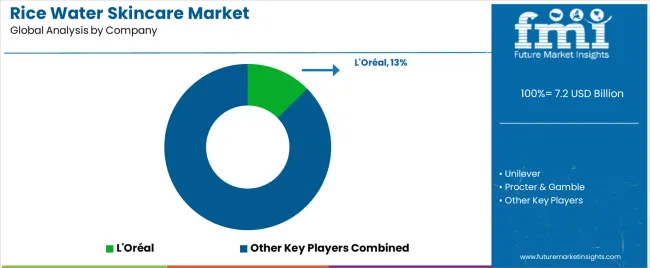
The competitive landscape of the rice water skincare market is described by a mix of established players and emerging brands vying for market share. Major companies leverage extensive distribution networks and brand recognition to maintain dominance, while smaller players focus on innovation and niche marketing strategies.
As consumer demand is directly proportional to natural skincare solutions grows, competition intensifies, driving ongoing product development and market expansion efforts.
Some of the key developments
| Attributes | Details |
|---|---|
| Estimated Market Size in 2025 | USD 7.2 billion |
| Projected Market Valuation in 2035 | USD 13.2 billion |
| Value-based CAGR 2025 to 2035 | 6.2% |
| Forecast Period | 2025 to 2035 |
| Historical Data Available for | 2020 to 2025 |
| Market Analysis | Value in USD billion |
| Key Regions Covered | North America; Latin America; Western Europe; Eastern Europe; South Asia and Pacific; East Asia; Middle East and Africa |
| Key Market Segments Covered | Product Type, Skin Type, Consumer Orientation, Sales Channel, Region |
| Key Countries Profiled | The United States, Canada, Brazil, Mexico, Germany, The United Kingdom, France, Spain, Italy, Russia, Poland, Czech Republic, Romania, India, Bangladesh, Australia, New Zealand, China, Japan, South Korea, GCC countries, South Africa, Israel |
| Key Companies Profiled | Procter & Gamble; Unilever; L'Orial; Johnson & Johnson; Estée Lauder; Shiseido; Avon Products; Amorepacific Corporation; Kao Corporation; Beiersdorf; Colgate-Palmolive; Henkel AG & Co. KGaA; Coty Inc.; Revlon; The Body Shop (owned by Natura & Co) |
The global rice water skincare market is estimated to be valued at USD 7.2 billion in 2025.
The market size for the rice water skincare market is projected to reach USD 13.2 billion by 2035.
The rice water skincare market is expected to grow at a 6.2% CAGR between 2025 and 2035.
The key product types in rice water skincare market are moisturizers, face packs/masks, cleansers, toners, serums and other skin care products.
In terms of skin type, dry skin segment to command 18.9% share in the rice water skincare market in 2025.






Full Research Suite comprises of:
Market outlook & trends analysis
Interviews & case studies
Strategic recommendations
Vendor profiles & capabilities analysis
5-year forecasts
8 regions and 60+ country-level data splits
Market segment data splits
12 months of continuous data updates
DELIVERED AS:
PDF EXCEL ONLINE
Rice Bran Fatty Alcohols Market Size and Share Forecast Outlook 2025 to 2035
Rice Shampoo Bar Market Size and Share Forecast Outlook 2025 to 2035
Rice Bran Oil for Skin Care Market Size and Share Forecast Outlook 2025 to 2035
Rice Bran Oil Infusions Market Analysis - Size and Share Forecast Outlook 2025 to 2035
Rice Milling Machine Market Size and Share Forecast Outlook 2025 to 2035
Rice Bran Derivatives Market Size and Share Forecast Outlook 2025 to 2035
Rice Mill Machine Market Size and Share Forecast Outlook 2025 to 2035
Rice Derivative Market Size and Share Forecast Outlook 2025 to 2035
Rice Polishing Machines Market Size and Share Forecast Outlook 2025 to 2035
Rice Bran Oil Market Analysis by Type, End User, and Region Through 2035
Rice Processing Machine Market Size and Share Forecast Outlook 2025 to 2035
Rice Bran Wax Market Analysis - Size, Share, and Forecast 2025 to 2035
Rice Cake Market Analysis - Size, Share, and Forecast Outlook 2025 to 2035
Rice Milk Market Trends - Dairy-Free Nutrition & Industry Growth 2025 to 2035
Rice-based Products Market Analysis by Product Type, Distribution Channel, and Region Through 2035
Market Share Breakdown of Rice Shampoo Bar Manufacturers
Rice Paper Stand Up Pouch Market Growth & Sustainable Packaging 2024-2034
Rice Protein Market
Rice Water Haircare Market Size and Share Forecast Outlook 2025 to 2035
Rice Water Shampoo Market Size and Share Forecast Outlook 2025 to 2035

Thank you!
You will receive an email from our Business Development Manager. Please be sure to check your SPAM/JUNK folder too.
Chat With
MaRIA